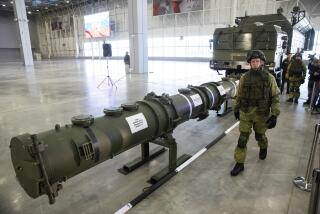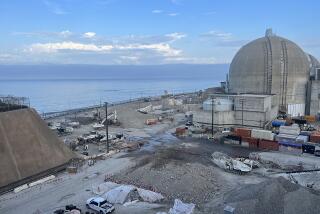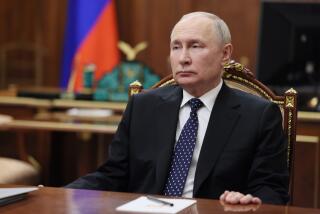Soviets Begin Destroying Missiles as Inspectors Watch
- Share via
SARYOZEK, Soviet Union — With a huge blast that shook the ground miles away, the Soviet Union on Monday began destroying nuclear missiles under the superpower Intermediate-range Nuclear Forces Treaty.
As U.S. inspectors stood by, a Soviet officer shouted “Fire!” and four SS-12 rockets--their nuclear warheads removed in advance--exploded together in a fiery flash in a depression among the hills here, about 120 miles northwest of Alma-Alta, the capital of Soviet Kazakhstan.
“Blow up another one!” shouted several Western anti-nuclear activists invited as observers as Soviet officers shook hands with one another and the U.S. inspectors peered through binoculars at the smoke.
The SS-12s, which had been deployed with Soviet forces in East Germany, were the first cluster of missiles to go up in smoke under the INF accord, which went into effect June 1.
Under the accord, the Soviet Union has promised to scrap 1,752 missiles with a range of from 300 to 3,400 miles while the United States will destroy about 800.
2 Tons of Dynamite Used
Soviet officials said earlier that up to two tons of dynamite would be used to destroy the SS-12s at the Saryozek range specially designed for the purpose.
The warheads had been removed from each of the nine-ton missiles before they were transported to the demolition area, said Lt. Col. Alexander Borodin, who is in charge of the site.
Borodin said the nuclear charges “will be used for peaceful purposes only” but he declined to say where. The Soviet Union frequently uses underground nuclear blasts in mineral prospecting and road-building in mountainous areas.
The INF treaty, hailed by both sides as the dawn of an era of disarmament, was signed last December during a Washington summit between Soviet leader Mikhail S. Gorbachev and President Reagan.
A team of 10 American inspectors led by U.S. Air Force Lt. Col. Michael Hritsik monitored the blast from a hilltop 2 miles away.
On the next hill stood some 20 Soviet and foreign journalists and about 100 anti-nuclear activists from around the world who cheered the explosions. They then went down to the crater and poked around in the rubble for souvenirs in the twisted metal.
More to Read
Sign up for Essential California
The most important California stories and recommendations in your inbox every morning.
You may occasionally receive promotional content from the Los Angeles Times.










